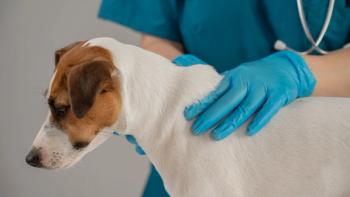
Feline alopecia (Proceedings)
Feline alopecia is a common dermatologic presentation because of the overt clinical findings observed by the owner. Alopecia can broadly be categorized into traumatic induced, hair follicle/shaft damage, and hair cycle abnormalities.
Feline alopecia is a common dermatologic presentation because of the overt clinical findings observed by the owner. Alopecia can broadly be categorized into traumatic induced, hair follicle/shaft damage, and hair cycle abnormalities. As with other dermatologic disorders, an organized history is essential to limit potential differential diagnoses. Simple diagnostic procedures can then be performed to achieve an accurate diagnosis and treatment plan.
Alopecia can be defined as "hair loss". For the purposes of this presentation, alopecia will include all causes of hair loss including an observed thinning of the hair (hypotrichosis) due to broken or plucked hairs. Various stages of shedding can also be perceived as an alopecic disorder.
There are several diagnostic techniques available to aid in a diagnosis. A magnifying lens is helpful to assess the intensity of the alopecia. Hairs from the affected areas should be carefully plucked with a forceps and placed on a drop of mineral on a clean glass slide. A cover slip is applied before examination under low power. This procedure is referred to as a "trichogram". Normal tips of the hairs will come to a tapering point. Broken hairs will have a blunt, fractured appearance and are suggestive of excessive grooming behavior. Occasionally, fungal infected hairs will be identified as "fuzzy hairs" with a distorted cuticle. Fungal spores can also be identified with this simple procedure.
Skin scrapings are an under utilized diagnostic tool in feline dermatology. Demodex mites are an important cause of alopecia. Other parasitic causes of alopecia include chiggers, lice, Notoedres cati, and Lynxacara radovski (cat fur mite). Diagnosis is usually straightforward by use of tape preparations, magnifying lens examination, and skin scrapings.
At times it can be difficult to discern physiologic alopecia from plucked or groomed hairs. In this instance, biopsy and histopathology can be helpful. It is essential to provide a thorough history and description of physical findings to the pathologist. Select lesional skin, and normal haired skin, and make certain that they are identified correctly. Histopathology can be helpful in differentiating congenital/hereditary, endocrine, and telogen defluxion from allergic causes. However, in mildly inflamed, traumatic induced alopecic skin, the results may appear as "normal".
A complete blood count with serum chemistry profile is sometimes useful as a diagnostic tool for feline alopecia. Most allergic causes will have changes in eosinophillic counts but are not diagnostic alone. If there is any clinical evidence of systemic illness associated with the alopecia, then laboratory blood work is indicated.
There are three major causes of feline alopecia associated with damage to the hair follicle or hair shaft. These are demodicosis, dermatophytosis, and occasionally bacterial folliculitis. Other infectious diseases are occasionally encountered.
Demodex cati is a follicular dwelling mite and has a long slender tail, similar to canine demodex mites. Deep skin scrapings are the diagnostic procedure of choice. These mites are usually seen affecting a single pet in the household. Immuno-compromising diseases such as hyperthyroidism, FIV, FeLV, and underlying malignancy should be sought as the cause of demodicosis. Treatment for the cause of demodex is more important than resolving the mites. Although ivermectin and amitraz may be helpful, their side effects and toxicity preclude usage.
Dermatophytosis frequently presents as an alopecic disorder, with or without concurrent scaling. Pruritus may be present. The important historical findings would include the potential for exposure, younger aged patients, and potential involvement of other household animals and people. Diagnosis is made on the basis of examination of plucked hairs and a positive fungal culture. A Wood's lamp examination may be a useful screening tool to provide a tentative diagnosis. However, many false negative results occur. A fungal culture must be done for an accurate diagnosis and identification of the correct genus and species. The derm duet by Bacti-labs is an excellent product (
Bacterial folliculitis is an uncommon cause of feline alopecia. When severe traumatic alopecia is encountered, a concurrent bacterial overgrowth may ensue. Cytological examination and bacterial culture make a diagnosis. A positive response to antibacterial therapy can be a helpful diagnostic tool.
The most common cause of feline alopecia is due to (pruritic) traumatic causes. These include barbering of the hairs leading to broken hairs, and plucking of the hairs leading to various stages of broken or completely alopecic regions. Traumatic causes are usually pruritic. Occasionally, there is a behavioral cause for excessive grooming but this is a diagnosis by exclusion. Behavioral causes are far less common than pruritic causes.
Feline allergy to fleas, inhaled allergens, and food allergens are among the most common causes of alopecia. A thorough history can help to differentiate pruritic (traumatic induced) from spontaneous alopecia. However, some cats are secretive groomers and the owner many not see the cat lick or pluck at the hairs. Many times there is a concurrent observation of increased hairballs because of the consumption of hair. A fecal exam can also afford a rough estimate of the increased consumption of hair. Fleas might actually be found on the fecal floatation confirming the presence of fleas in the environment. Intradermal allergen testing and or a restricted food trial make a diagnosis.
Behavioral causes of alopecia are usually diagnosed by accurately ruling-out other more common causes. There are times when a striking historical finding at or near the time of the onset of clinical findings is too blatant to ignore. Examples of this might include the addition (or deletion) of a family member or pet, or changes in the environment (construction, outdoor cats forced to remain indoors, etc). The best way to treat behavior induced alopecia is to correct the inciting cause. Corticosteroid usage should be avoided, as there will be no physiologic advantage to using these drugs. By the same token, hormonal drugs should be reserved as a last resort treatment due to their potential for severe adverse side effects. Occasionally, diazepam and newer psychoactive agents can be considered.
When there is a sudden onset of alopecia and other causes of alopecia are ruled out, there are some uncommon circumstances to consider. Cats with urinary tract cystitis may suddenly lick exuberantly at the caudal abdominal region. Similar findings may also be seen in cats with impacted anal sacs. For both of these entities, the traumatic alopecia may extend to the caudal rear limbs, perianal region, and proximal aspect of the tail head. A urinalysis and palpation of the anal sacs are warranted for all middle-aged to senior feline patients with acute onset of traumatic induced alopecia.
There are several causes of alopecia related to hair cycle abnormalities. Congenital hypotrichosis and alopecia universalis (Sphinx cat) is usually a simple diagnosis to make and can be confirmed with histopathology. Endocrine and metabolic causes of alopecia can be a little more challenging to make an accurate diagnosis. Hyperthyroidism can be a cause of alopecia and the straightforward nature of the diagnosis makes it unworthy of coverage at this time. Feline hyper-adrenocorticism is an uncommon disorder that is very difficult to definitively diagnose. Clinical findings include PU/PD associated with mild diabetes and a poor unkempt hair coat. There is usually a thinning of the skin associated with the catabolic effects of excessive endogenous corticosteroid. Diagnosis is made on historical and clinical findings and an abnormal high dosage dexamethasone suppression test (0.1 mg/kg). Treatment with metyrapone can be attempted but there is inconsistent clinical response. Surgical ablation of the adrenal glands would be curative; however, wound dehiscence and poor healing are severe complications. Diabetes mellitus alone or with hyperadrenocorticism should be treated appropriately. Telogen defluxion (or anagen defluxion) can be associated with postpartum alopecia. No treatment is necessary, as the condition will resolve with adequate time allowance. Similar acute onset hair loss may be seen days, weeks, or months following a febrile episode or systemic illness. Accurate historical information and histopathology can lead to a diagnosis.
Newsletter
From exam room tips to practice management insights, get trusted veterinary news delivered straight to your inbox—subscribe to dvm360.






